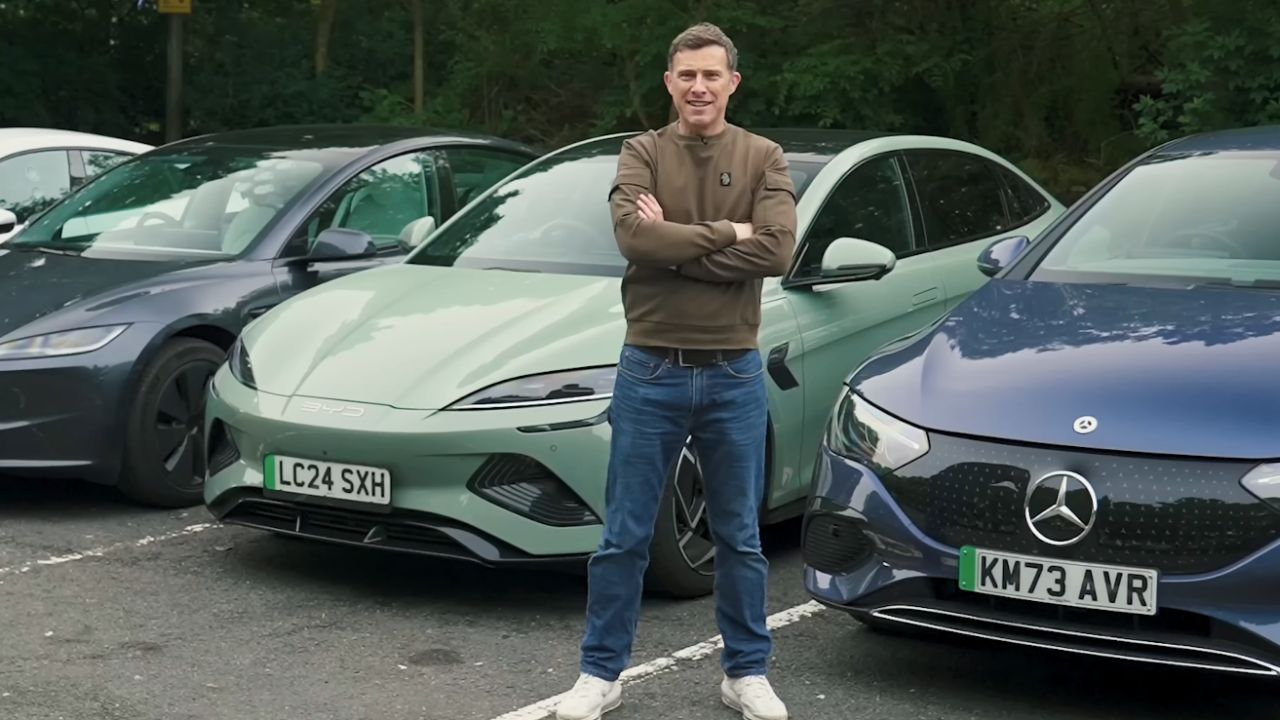Youtubers Pushed Six Electric Vehicles to Their Limit; Which One Had the Most Range?

YouTube channel Carwow and its host, Matt Watson, decided to put six state–of–the–art electric sedans through a real–world driving range test.
The electric cars they tested were the BYD seal, the Tesla Model 3 Long Range, the Polestar 2 Long Range Single Motor, the BMW i5 M Sport, the Porsche Tycan Performance Battery Plus, and the Mercedes-Benz EQE 300.
The Test

For this real–world test, Matt Watson and his team drove these cars through the United Kingdom as regular drivers would. That means they were operating these vehicles in normal drive mode while using each car’s heating as they needed to feel comfortable. They also drove the speed limit the entire time while mostly driving on the freeway.
However, when low battery warnings started to come on in each vehicle, they would switch to eco–driving mode and reduce their speed to push these cars as far as they could go in order to find out their real–world driving range limits under realistic conditions.
It’s also worth noting that towards the end of the video when these cars were running low on battery, they faced some heavy rain. There was plenty of reality these cars had to face during this test.
Additionally, it’s important to note that since this test is happening in the U.K., there are likely to be differences between these models and the ones available in the U.S. One of the models they tested, the BYD Seal, is not available in the U.S. currently. Given the Biden Administration’s tariff on Chinese vehicles, it’s unlikely that U.S. buyers will have a chance to buy one.
Byd Seal Design

The BYD Seal has a starting price of around $58,000. It’s capable of producing 312-hp and can dash from 0 to 60 mph in 5.9 seconds on a rear–drive motor. It has a battery capacity of 82.5 kWh and an advertised driving range of 354 miles.
After the car ran out of battery, its driver managed to squeeze another six or so miles out of it. As its battery ran out, the vehicle started driving at progressively slower speeds. When it died, the car immediately engaged the parking brake and the driver was unable to put it into neutral.
So, he locked the car for five minutes and then returned to it and was able to turn it back on. It then had enough juice for him to drive it to a charging station around the corner from where it died.
In the end, the BYD Seal was able to drive 310 miles, 87.5 percent of its advertised range of 354 miles. Its energy consumption during the test was 3.8 mi/kWh.
Tesla Model 3 Long Range

The Tesla Model 3 has an estimated driving range of 390 miles with a battery capacity of 75 kWh. The dual–motor long–range model that Watson was driving cost around $63,000. However, the single–motor version is available for around $51,000.
The Tesla was able to drive an additional 23 miles after the car said it had no battery left, according to its test driver. Unfortunately, when the Tesla finally did run out of battery it was within 5 feet of a charging station, but the cable was not long enough to reach the car.
The Tesla automatically put itself in park, so the driver was unable to put it in neutral to push the car to the charger. Its electronic doors and windows also had trouble working at this point.
The Tesla died after driving 352 miles, which is 90 percent of its advertised range of 390 miles. Its energy consumption during the test was the best of the six electric cars at 4.7 mi/kWh. So, even though the Tesla has less battery capacity than the other electric sedans in this test, it was still the most efficient.
Polestar 2 Long Range Single Motor

The Polestar 2 comes with a battery capacity of 79 kWh and an advertised range of 406 miles. Watson noted that this particular Polestar 2 is more expensive than the other vehicles in its range because it is the long–range version and comes with all the options. According to him, it cost around $71,000. Usually, this car would be available for around $61,000 without all the bells and whistles.
Its single single motor sends around 300-hp to the rear wheels and Polestar claims it can sprint from 0 to 60 mph in 6.2 seconds.
According to its test driver, the Polestar 2 went into low power mode when its battery was drained and gradually lost speed. He was able to drive the car for about 25 minutes in low battery mode. However, when the Polestar 2 died, it really died. All of its screens, everything in it went dark, and there was no juice left.
It was able to drive 332 miles before it died. That’s 82 percent of its advertised range of 406 miles. Its energy consumption during the test was 4.2 mi/kWh.
BMW I5 M Sport

According to Watson, the BMW i5 starts at around $86,000. However, the model he was driving for the test cost over $118,000 because it came with all the options. A single motor powers its real wheels with 340 hp. It can accelerate from 0 to 60 mph in six seconds.
The electric sedan’s battery capacity is 81 kWh, and its estimated driving range is 362 miles. However, it also turned out to be the least efficient vehicle in terms of energy consumption during this test at 3.7 mi/kWh. In total, the BMW was able to drive 296 miles, which is 82 percent of its advertised range of 362 miles.
It was able to drive a further 15 miles after the car said it had run out of battery. Like the other electric sedans in this test, it progressively reduced its power as it died until it came to a complete stop.
Porsche Tycan Performance Battery Plus

The Porsche Taycan has the largest battery capacity of any of the test cars at 97 kWh. However, its efficiency was only 3.8 mi/kWh. Its advertised range is 421 miles. According to Watson, the entry–level Tycan starts at over $110,000. However, the one he was driving for the test, which comes with an extended battery range, cost around $115,000.
Its power output is low for a Porsche. It comes with a single motor that sends 408-hp to the real rear wheels. It can launch from 0 to 60 mph in about 4.5 seconds.
When the Porsche’s battery began to die, it flashed a warning that its charge level was critical and that its driving performance would be limited. It also instructed the driver to park the vehicle safely. It was only able to drive an additional 1.5 miles after its battery ran out.
In the end, it was able to drive 368 miles during the test, which is 88 percent of its advertised range of 421 miles.
Mercedes–Benz Eqe 300

The Mercedes has a battery capacity of 89 kWh, with an advertised range of 380 miles. The entry–level car for this model costs around $87,000, according to Watson.
However, he does note that the model he drives in the video is no longer available. Mercedes has a new similar entry–level model out now that gets around 50 miles more driving range and likely has similar performance.
That model is currently unavailable to the press, so he was not able to drive it as part of his real–world test. It has a single–drive motor that sends 245-hp to the rear wheels. It can accelerate from 0 to 60 mph in around 7.3 seconds.
Its test driver said he was able to do a few miles after its battery was drained. When the car finally died, the vehicle put itself into park and would not let him move it at all. After turning it off for a little bit and then turning it back on, the test driver found that the car had enough power for him to put it in drive again and crawl up to a charger that was only a few meters away.
In the end, the Mercedes was able to drive 357 miles, which is 94 percent of its advertised range of 380 miles. Its energy efficiency during the test was 4.0 mi/kWh.





